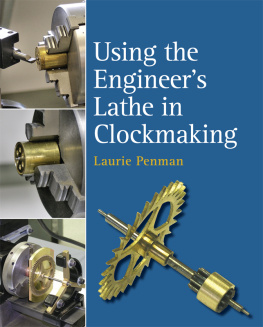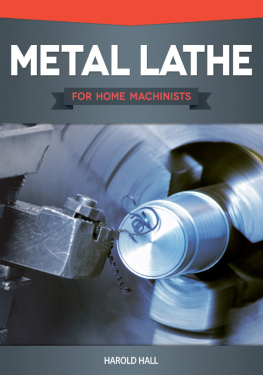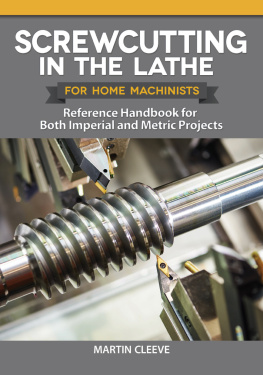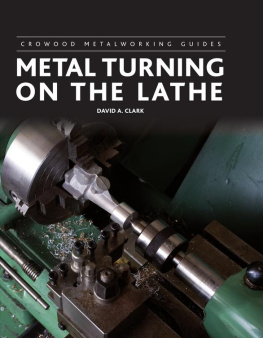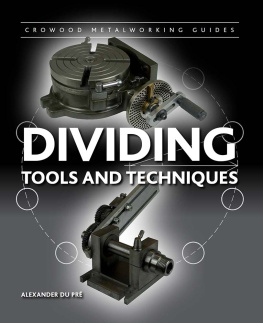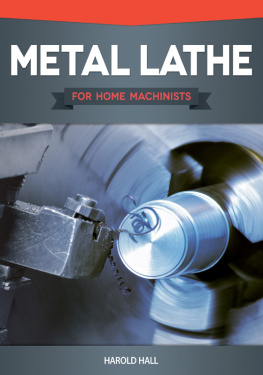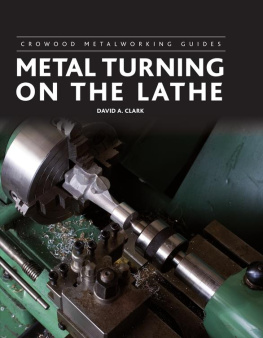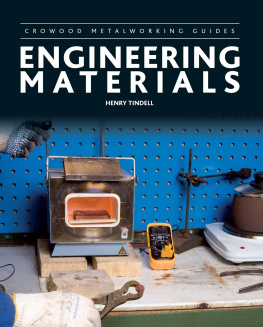
CROWOOD METALWORKING GUIDES
THE MINI-LATHE
NEIL M. WYATT

First published in 2016 by
The Crowood Press Ltd
Ramsbury, Marlborough
Wiltshire SN8 2HR
www.crowood.com
This e-book published 2016
The Crowood Press 2016
All rights reserved. No part of this publication may be reproduced or transmitted in any form or by any means, electronic or mechanical, including photocopy, recording, or any information storage and retrieval system, without permission in writing from the publishers.
British Library Cataloguing-in-Publication Data
A catalogue record for this book is available from the British Library.
ISBN 978 1 78500 129 1
1 Why a Mini-Lathe?
Ask a dozen model engineers what is the best lathe for me? and you will get two dozen answers! One of the finest writers on the hobby, Edgar Westbury (E.T.W.), said: The so-called ideal lathe is in practice a romantic myth. He had the perception to realize we all have different needs and the best lathe for each of us will always be a compromise. Mini-lathes provide capacity, capability and many useful features at an affordable price. They may not be ideal for everyone but they have proven the best route into hobby engineering for tens or hundreds of thousands.
Most modern books on small lathes have been written by authors more familiar with larger machines or classic older lathes. Inevitably, their experience with larger machines colours their approach to these machines.
My own lathe, in regular use for the past sixteen years, is a Clarke CL300M mini-lathe (). This is one of the main machines featured in this book. In using the machine I have been pleasantly surprised while some aspects of the lathe are made to keep costs down, it is rigid, accurate and reliable.

Fig. 1.1 The authors Clarke CL300M mini-lathe in more or less original condition.
This book deals with what I have discovered during those sixteen years of use, from choosing a lathe, basic safety and setting it up properly, through a range of basic turning skills, to tackling some more challenging machining operations and making useful accessories. I cant guarantee every single point I cover will apply to every variant of mini-lathe but, by the same token, many of the general principles will apply to any lathe of similar size.
I have made numerous modifications and additions to my machine; some of these are standard upgrades, others are of my own devising. Be assured that none of them are essential to using a mini-lathe but also recognize the basic machine has plenty of scope for modification and tuning if you are, like me, a tweaker.
This book gives most dimensions in metric and imperial units. These are not intended to be exact equivalents, especially where a dimension is given as a guide. For example, a thousandth of an inch is exactly 0.0254mm but I may well write something such as about 0.02mm (0.001in).
I would like to thank the many fellow mini-lathe users who both knowingly and unwittingly have helped me over the years with advice, ideas and guidance. In particular, the writings and ideas of Alastair Sinclair and Mike Cox have been a source of ideas and inspiration. They say there are no new ideas in engineering and I apologize if I have unintentionally copied anyone without giving due credit.
I would like to thank Arc Euro Trade, Axminster Tools & Machinery, Chester Machine Tools, Eccentric Engineering, Machine Mart and Warco for permission to use photographs of their machines, as well as SIEG for permission to use extracts from its user manual.
Finally, for a book like this I also needed access to an unmodified machine and various accessories to demonstrate certain points. I would like to thank Ketan Swali of Arc Euro Trade for the opportunity to use its studio to photograph a new, unmodified SIEG mini-lathe and also for his advice on the various subtleties and technical aspects of these worthy machines.
2 Safety
Some readers will groan at this point but, unless one has seen the aftermath of an industrial accident, is easy to be blas about the risks associated with machine tools.
Lathes are one of the slower and quieter tools so it is easy to get complacent about the risks they pose. However, complacency is a cause of accidents. Even a mini-lathe is capable of causing serious injury from sharp tools, flying swarf (debris) and collisions or entanglement with moving parts. Dont panic, though. Lathe safety mostly means using your common sense and keeping the working area clean and tidy. Here are some pointers towards the safe use of any workshop lathe but, remember, safety is your responsibility and if you are not sure ask!
Emergency Stop
Make sure you are familiar with the emergency stop button. It does no harm to use this to stop the lathe in day-to-day operations and the more familiar you are with using it, the faster you will be able to hit it in an emergency ().

Fig. 2.1 If things start to go wrong, hit the emergency stop.
Protective Equipment
Unlike many machine tools, lathes do not demand a lot in the way of personal protective equipment. The HSE recommends eye protection is worn when using a lathe and if cutting something such as brass, which can send a vertical shower of small chips into the air, full eye protection is essential (). For most turning, many people find a pair of safety spectacles are sufficient but bear in mind that flying swarf is not the only risk it is possible for loose work pieces to fly out of the chuck at high speed.

Fig. 2.2 A pair of safety googles is an excellent investment.
Electricity
As with any electrical equipment, take the usual care with leads and around the electrical parts of the machine, bearing in mind lathes move and wires can be drawn into machinery. Ensure the plug is wired correctly and any fuses that blow are replaced with the same type and value. If you have an electrical problem or fuses blow repeatedly, consult an electrician. Do not attempt to dismantle or repair any electrical elements of the machine unless you are competent to do so. If you use cutting fluid of any kind, take great care to make sure it goes nowhere near the motor, control box or wiring harness. Finally, some mini-lathes do not have a seal around the leadscrew. This allows swarf to potentially worm its way into the control box, with disastrous results. I have first-hand experience of this happening.
Guards
Older mini-lathes are equipped with tiny guards that serve little practical purpose as they rarely offer real protection in the actual working area and in some cases limit the usability of the machine ().
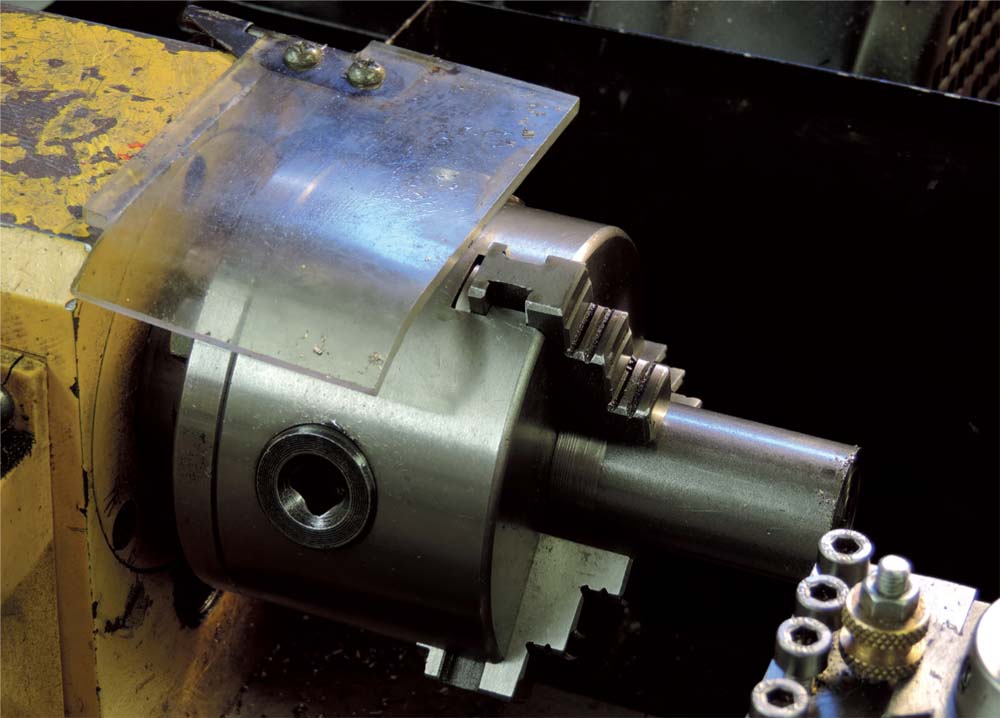
Fig. 2.3 The guards on early mini-lathes left something to be desired.

Next page


